

How to add color to your garden? Combine plants, garden furniture and mark out selected portions of the garden for specific functions, learn the art of creating a garden full of colors!
Read also:
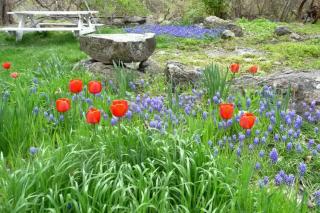 A dazzling colored garden even in winter? If you choose the right species, you’ll succeed! The goal is to stage the blooming times, so that there’s always something blooming somewhere – that way you’re guaranteed to have as stunning a garden in December as you have in May.
A dazzling colored garden even in winter? If you choose the right species, you’ll succeed! The goal is to stage the blooming times, so that there’s always something blooming somewhere – that way you’re guaranteed to have as stunning a garden in December as you have in May.
Primroses, typically among the bloomers that signal the coming of spring, will unfurl multi-colored flower umbels. They’re the first spring touches from a long list of bulb flowers (hyacinth, tulip, Narcissus…), perennials (Aubrieta, Bergenia, Saint John’s wort…) and shrubs (Daphne, Gardenia, Pittosporum…).
Of course, taller trees are also part of the colorfest, with magnolia, ornamental cherry and flower quince. Summer will also bring on an overload of pastel flowers, and then fall stands out once the fiery foliage of trees and shrubs matures, like that of shrubby sage.
So what about winter? Get your hands on a specimen of Camellia bukohan, which sports crimson red flowers from January to March, and try to find a few yellow-blooming mahonia shrubs or winter mimosa trees. A special variety of winter heather, ‘December Red’, won’t go unnoticed in winter, and neither will any type of Viburnum bordnantense.
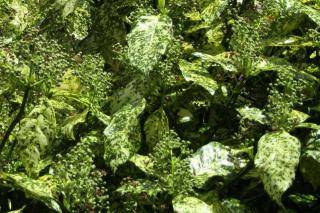 Color – though at first thought, flowers come to mind, sometimes foliage and bark does an even better job. In dry regions, you can certainly try planting agave, which creates a massive sphere of succulent leaves. Some species have striped leaves; others are entirely tinted blue.
Color – though at first thought, flowers come to mind, sometimes foliage and bark does an even better job. In dry regions, you can certainly try planting agave, which creates a massive sphere of succulent leaves. Some species have striped leaves; others are entirely tinted blue.
The Aucuba japonica ‘Golden King’ is a type of evergreen shrub for which the leaves are yellow with little green dots (the opposite of the common variety).
Let’s not forget Coprosma and its shiny red leaves that dive into deep purple hues around the edges.
Even fruits can outshine flowers! For instance, consider the pearly-white berries of the snowberry bush. This tree is a botanical treasure thanks to its pink or white berries that cover the shrub from August to November.
Extraordinary bark! In winter, the leafless stems of Cornus sanguinea reveal their neon orange or blood red color, depending on the variety.
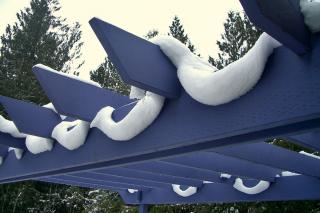 Nature shares a full palette of colors, but sometimes it’s hard to get things right. That’s why a great solution is to factor the different objects and elements of the garden in the picture! An orange wall at the back of the garden will happily jostle for attention with the deep green of darker plants, or with the shimmering blue of a swimming pool.
Nature shares a full palette of colors, but sometimes it’s hard to get things right. That’s why a great solution is to factor the different objects and elements of the garden in the picture! An orange wall at the back of the garden will happily jostle for attention with the deep green of darker plants, or with the shimmering blue of a swimming pool.
It’s possible to paint a pergola with a lavender-colored paint, to pair it with the wisteria that might be climbing on it, or to paint it bright red to match the snow-like blooms of a white-flowered vine. All wooden structures are easy to paint and varnish to the exact hue you want for your garden.
As for aluminum fences, it’s now easy to find them in every possible color. It’s a great way to create a colorful backdrop against which you can let a wide variety of plants imprint their visual mark. A quick and elegant option is to look for shrubs with variegated leaves, they will add volume: Cornus alba and Euonymus japonicus are two examples.
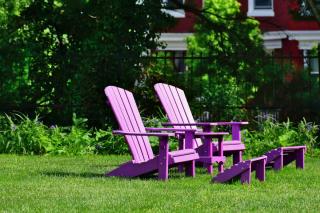 The advantage of garden furniture is that it’s usually easier to change than a tree or shrub is! So, you might spice up a noble, sober wooden deck with flashy garden seats and ornaments. Pillows are a favorite, and you can switch the cases out on a whim if need be. Sometimes patterns will make the scene more peppy.
The advantage of garden furniture is that it’s usually easier to change than a tree or shrub is! So, you might spice up a noble, sober wooden deck with flashy garden seats and ornaments. Pillows are a favorite, and you can switch the cases out on a whim if need be. Sometimes patterns will make the scene more peppy.
Other ornaments and pieces of furniture will help completely transform the atmosphere: carpet, mirror, sculptures, hanging plant compositions…
At night, lighting will give your garden a second life, and even a third, fourth or more if you’re able to change the colors of the bulbs easily. Adding a discrete spotlight inside a shrub bed, on the deck or terrace, and inside an adjoining body of water will also reveal hidden colors.
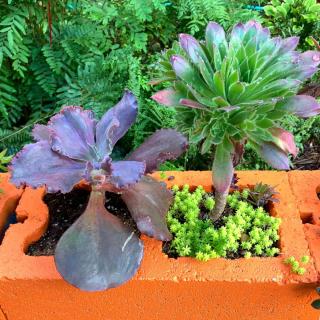 From plants to furniture, the amateur gardener might have perhaps too many options to choose from for a colored garden! How to pair colors together without the result turning out bad?
From plants to furniture, the amateur gardener might have perhaps too many options to choose from for a colored garden! How to pair colors together without the result turning out bad?
There is no fixed rule, but there is the general notion that some complementary color pairs, when side by side, are more harmonious than others. In our subconscious, complementary colors mutually support each other so that both stand out without competing. For instance, red will always seem more intense when surrounded with green. Similarly, yellow and purple fit together well, as do blue and orange.
However, in your own garden, you make the rules, so what matters is what pleases you most!